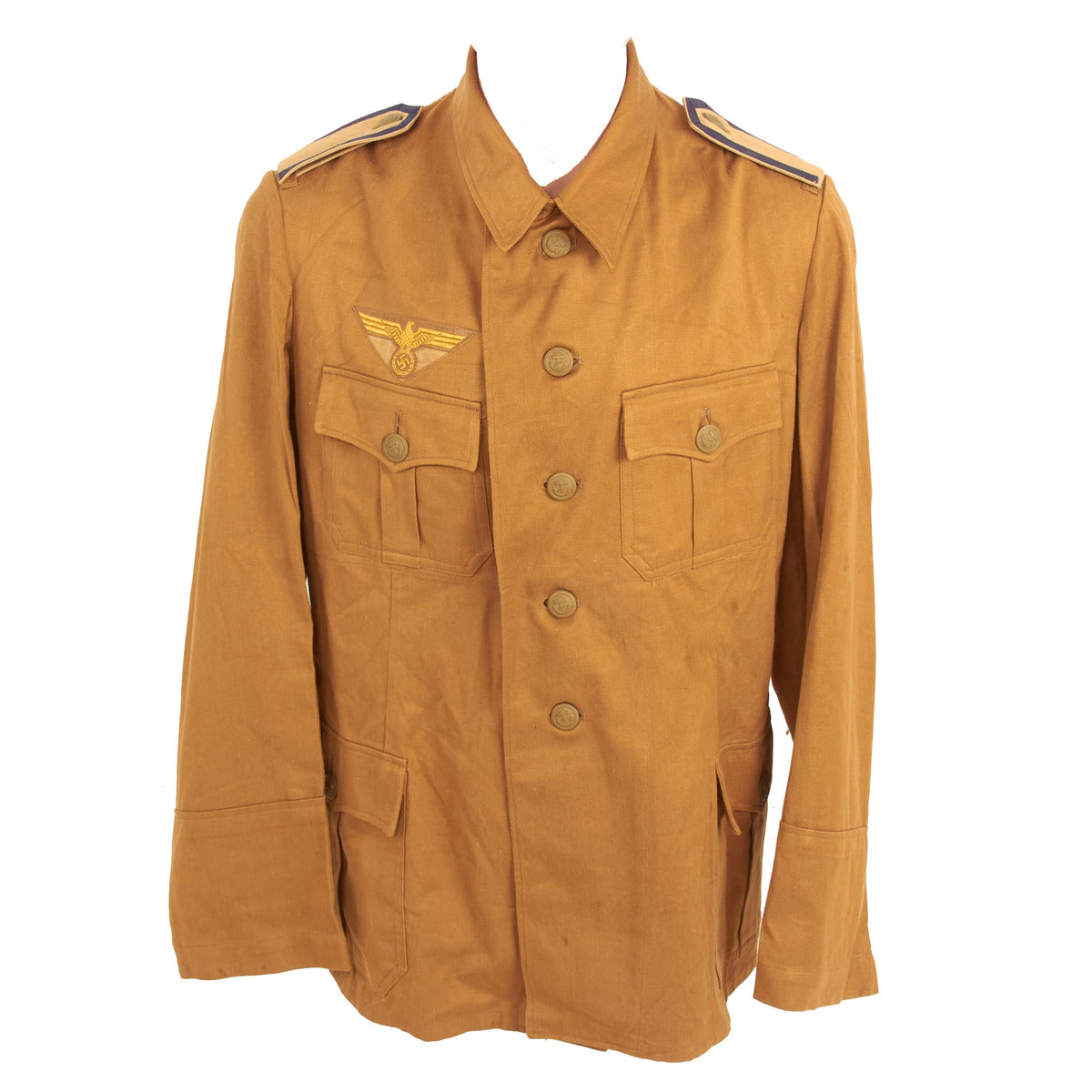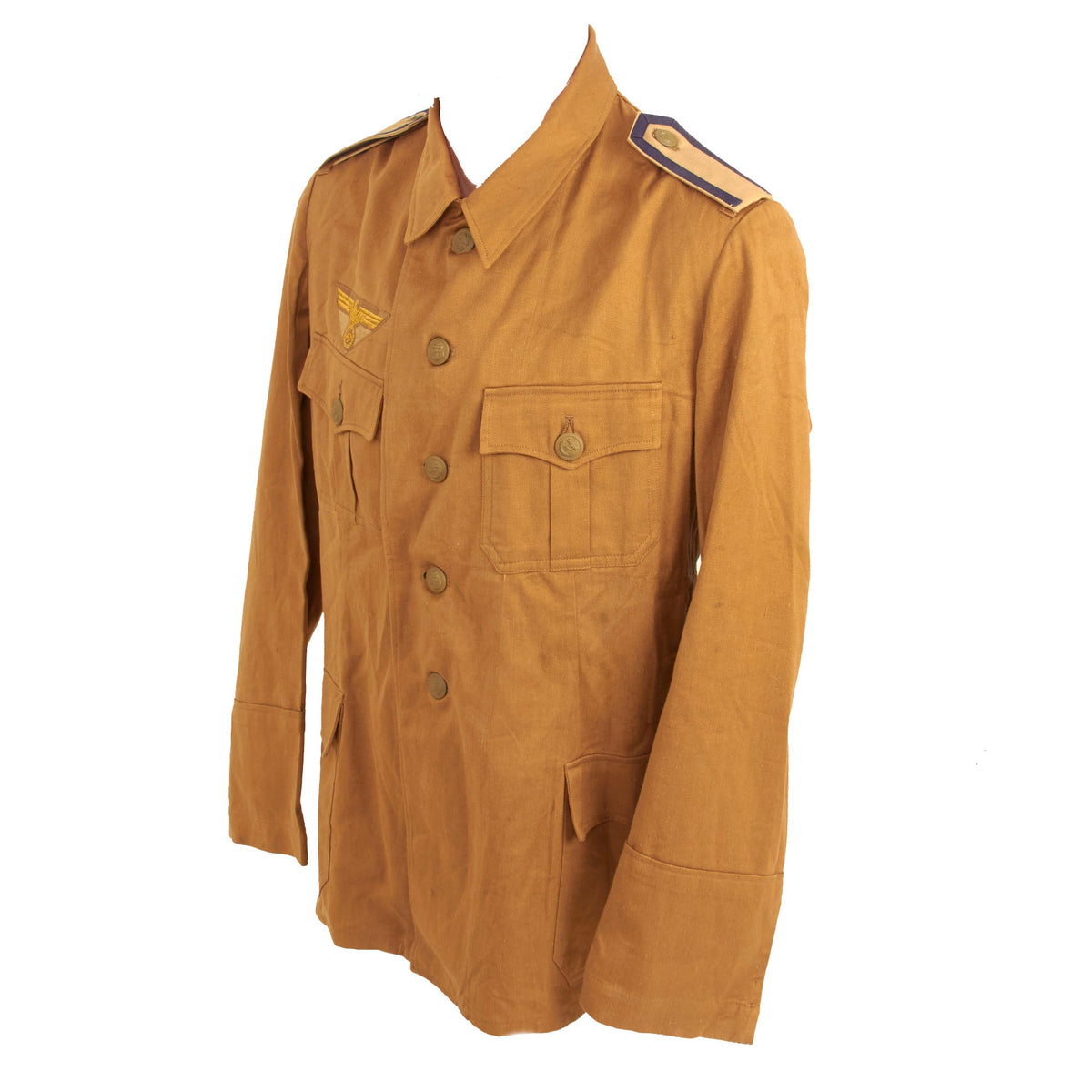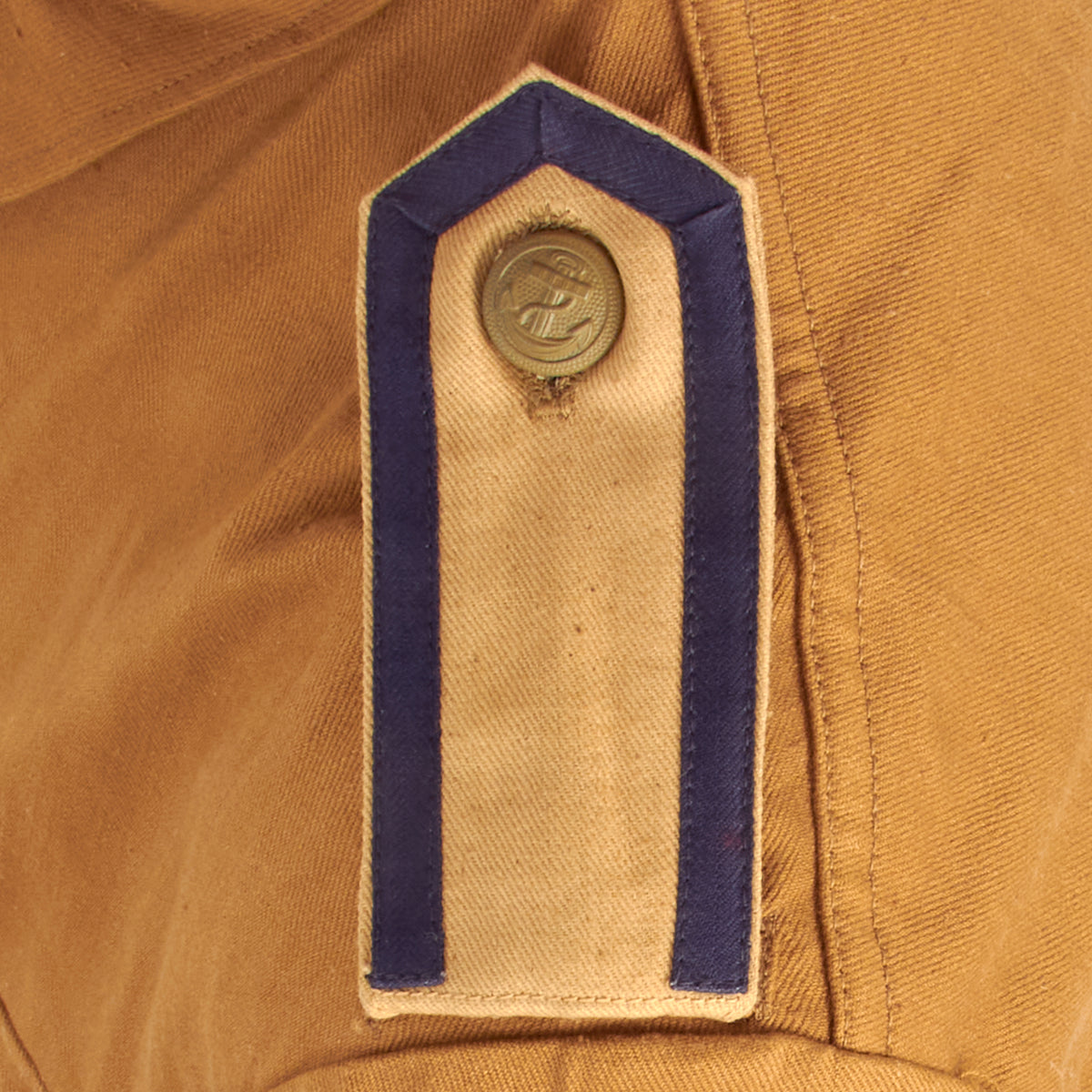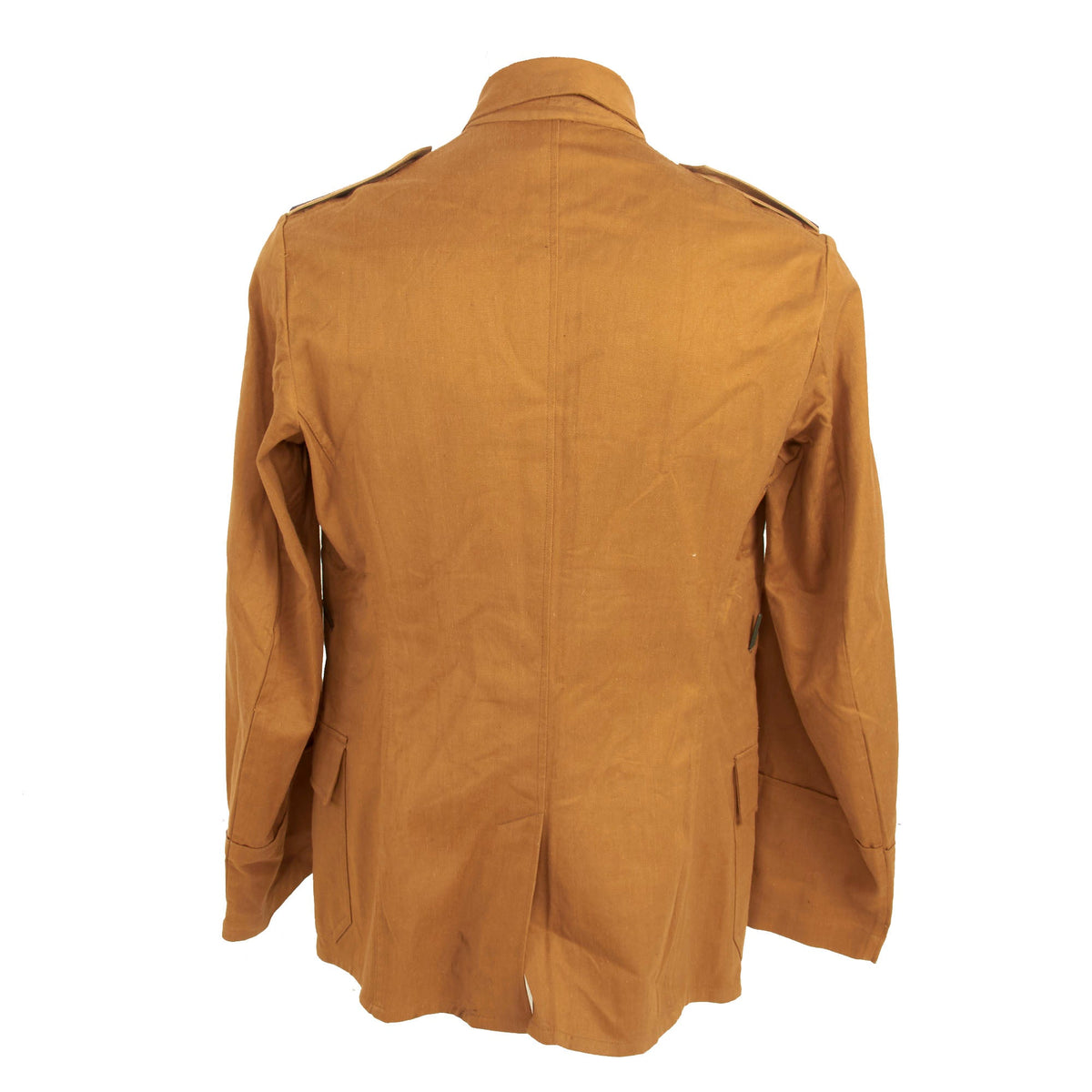Original German WWII Afrikakorps Set: Unissued Mint Khaki Kriegsmarine M43 Tunic & Shorts with 1942 Dated Bread Bag Original Items
$ 2.295,00 $ 573,75
Original Item: One-of-a-kind. In early 1941, the German military began their conquest of southern Europe. Due to the warmer climates of these areas, the German Army needed to equip its troops with a more suitable form of dress, and replace the standard wool based feldgrau uniforms. The new “tropical” uniforms were lighter in weight, and dyed in colors ranging from light tan to dark olive.
This is a fantastic USGI bring back set just purchased at a recent military show, consisting of some fantastic condition DAK uniform items, along with a great DAK “bread bag”. The uniform portion of the set is a 100% authentic German World War Two M43 Kriegsmarine Tropical Tunic with Petty Officer Maat Shoulderboards, and the Iconic Tropical Shorts. These were used by all branches, but the “anchor” buttons on the M43 tunic mean it is definitively for the Kriegsmarine navy. Even better, these two items are unissued and MINT, which is not a term we use lightly. The tunic even has the ORIGINAL PAPER MAKER TAG still sewn to it. They simply do not get any better than this!
The tunic is made out of lightweight cotton Twill weave material which has been dyed a nice khaki tan, and it has a matching color BeVO style breast eagle installed, with gold thread indicating Kriegsmarine issue. The front of the tunic has five original buttons for the main closure, and four pocket buttons, all of which are in fantastic shape. They are retained by circlips on the rear, and are all maker marked on the back. The interior is only lined on the top, with vents in the armpit areas, and has the usual adjustable straps for the belt hooks. The shoulder buttons are fitted with tropical Kriegsmarine shoulder boards for a Maat, equivalent to a U.S. Navy Petty officer, third class.
Under the button flap on the right side it is maker marked with Spiesshofer & Braun Heubach / Württ., and it has the ink stamped size information reading 43 100 65. This exactly matches what is on the paper tag sewn to the lower inside right. This most likely corresponds to the following measurements:
Torso Length: 43cm = 16.93 in.
Chest: 100cm = 39.3 in.
Sleeve: 65cm = 25.60 in.
The included shorts actually could be worn with the M43 Tunic in this set, and there are many period photographs that document this. Sometimes the tunic would be tucked in, or simply worn over the shorts. They are in fantastic unissued condition, and even are still have the maker mark from ;NEUERNER WAESCHEFABRIK, which simply means “New Laundry Factory”. Next to this area the numbers 84 over 27, which are the size markings for the shorts. These correspond to the following measurements:
Waist: 84cm = 33.07 in.
Inseam: 10.63 in.
We did measure the shorts, and these measurements check out.
The included bread bag is in very good condition, and is maker marked and dated on the hook tab, however only the 1942 date is clear. All of the buttons and snaps are present, with the only issue being that one of the spring clips on the strap is somewhat bent.
Overall a fantastic totally genuine Afrika Korps Uniform set, in nearly immaculate condition, with a totally correct period bread bag. This would be the perfect addition to any DAK or Kriegsmarine collection. Ready to display!
History of the German Africa Korps
The Afrika Korps or German Africa Corps (German: Deutsches Afrikakorps, DAK was the German expeditionary force in Africa during the North African Campaign of World War II. First sent as a holding force to shore up the Italian defense of their African colonies, the formation fought on in Africa, under various appellations, from March 1941 until its surrender in May 1943. The term “Afrika Korps” is pseudo-German (so-called “cod-German”), deriving from an incomplete German title. The German term referred solely to the initial formation, the Deutsches Afrikakorps (DAK), which formed part of the Axis command of the German and Italian forces in North Africa. The name stuck, with both news media and Allied soldiers, as the name for all subsequent German units in North Africa. The unit is known for having been commanded by Field Marshal Erwin Rommel.
The dry climate of Africa proved to be an issue with much of the standard leather field gear that the German Army usually used. It would dry out and crack quickly, and become unusable. To deal with this, the standard field gear such as belts, Y-straps, A-frames, bayonet frogs, and other items, were issued in special tropical web versions.
Fast Shipping with Professional Packaging
Thanks to our longstanding association with UPS FedEx DHL, and other major international carriers, we are able to provide a range of shipping options. Our warehouse staff is expertly trained and will wrap your products according to our exact and precise specifications. Prior to shipping, your goods will be thoroughly examined and securely secured. We ship to thousands clients each day across multiple countries. This shows how we're dedicated to be the largest retailer on the internet. Warehouses and distribution centres can be located throughout Europe as well as the USA.
Note: Orders with more than one item will be assigned a processing date depending on the item.
Before shipping before shipping, we'll conduct a thorough inspection of the items you have ordered. Today, the majority of orders will be delivered within 48 hours. The delivery time will be between 3-7 days.
Returns
The stock is dynamic and we cannot completely manage it because multiple stakeholders are involved, including our factory and warehouse. So the actual stock may alter at any time. It's possible that you may not receive your order once the order has been made.
Our policy is valid for a period of 30 days. If you don't receive the product within 30 days, we are not able to issue a refund or an exchange.
You can only return an item if it is unused and in the same state as the day you received it. You must have the item in its original packaging.
Related products
Uncategorized
Uncategorized
Uncategorized
Uncategorized
Uncategorized
Uncategorized
Uncategorized
Uncategorized
Uncategorized
Uncategorized
Uncategorized
Uncategorized
Uncategorized
Uncategorized
Uncategorized
Angolan Rebel 1970s era 60mm Inert Display Mortar from Angolan Civil War Original Items
Uncategorized
Uncategorized
Armoured Fighting Vehicles of the World: AFVs of World War One (Hardcover Book) New Made Items












































































